Support Vector Machine Based Classification for Hyperspectral Remote Sensing Images
支持向量机的战场直升机目标分类识别_李京华
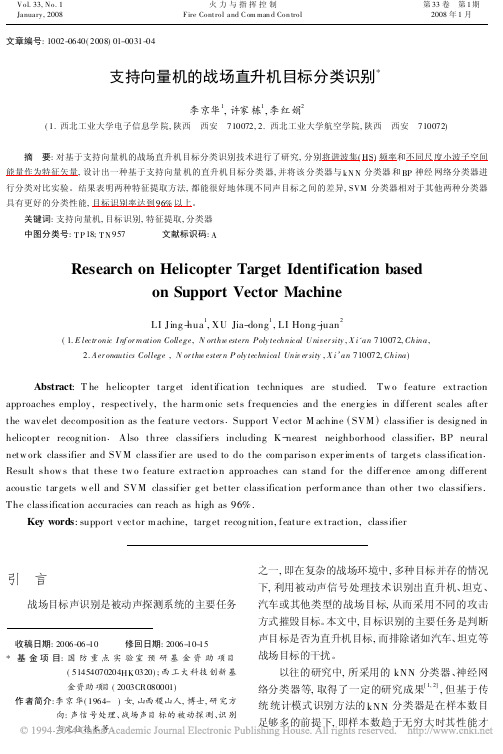
收稿日期:2006-06-10 修回日期:2006-10-15*基金项目:国防重点实验室预研基金资助项目(51454070204HK 0320);西工大科技创新基金资助项目(2003CR 080001) 作者简介:李京华(1964- )女,山西稷山人,博士,研究方向:声信号处理、战场声目标的被动探测、识别与定位技术等。
文章编号:1002-0640(2008)01-0031-04支持向量机的战场直升机目标分类识别*李京华1,许家栋1,李红娟2(1.西北工业大学电子信息学院,陕西 西安 710072,2.西北工业大学航空学院,陕西 西安 710072) 摘 要:对基于支持向量机的战场直升机目标分类识别技术进行了研究,分别将谐波集(HS)频率和不同尺度小波子空间能量作为特征矢量,设计出一种基于支持向量机的直升机目标分类器,并将该分类器与kN N 分类器和BP 神经网络分类器进行分类对比实验。
结果表明两种特征提取方法,都能很好地体现不同声目标之间的差异,SVM 分类器相对于其他两种分类器具有更好的分类性能,目标识别率达到96%以上。
关键词:支持向量机,目标识别,特征提取,分类器中图分类号:T P 18;T N 957 文献标识码:AResearch on Helicopter Target Identification basedon Support Vector MachineLI Jing -hua 1,XU Jia-dong 1,LI Hong -juan2(1.E lectr onic I nf or mation College ,N orthw estern Poly technical U niver sity ,X i 'an 710072,China ,2.A er onautics College ,N or thw ester n P oly technical Univ er sity ,X i ’an 710072,China ) Abstract :T he helicopter targ et identification techniques are studied.Tw o feature extraction approaches employ ,respectively,the harm onic sets frequencies and the energ ies in different scales after the wav elet decomposition as the feature vectors .Support Vector M achine (SVM )classifier is desig ned in helicopter recog nition .Also three classifiers including K -nearest neighborhood classifier ,BP neural netw ork classifier and SVM classifier are used to do the com pariso n exper im ents of targ ets classification .Result show s that these tw o feature extractio n approaches can stand for the differ ence am ong different acoustic tar gets w ell and SVM classifier g et better classification perform ance than other two classifiers.The classification accuracies can reach as high as 96%.Key words :support v ector m achine,targ et recog nition,featur e ex traction,classifier引 言战场目标声识别是被动声探测系统的主要任务之一,即在复杂的战场环境中,多种目标并存的情况下,利用被动声信号处理技术识别出直升机、坦克、汽车或其他类型的战场目标,从而采用不同的攻击方式摧毁目标。
Controlling the sensitivity of support vector machines
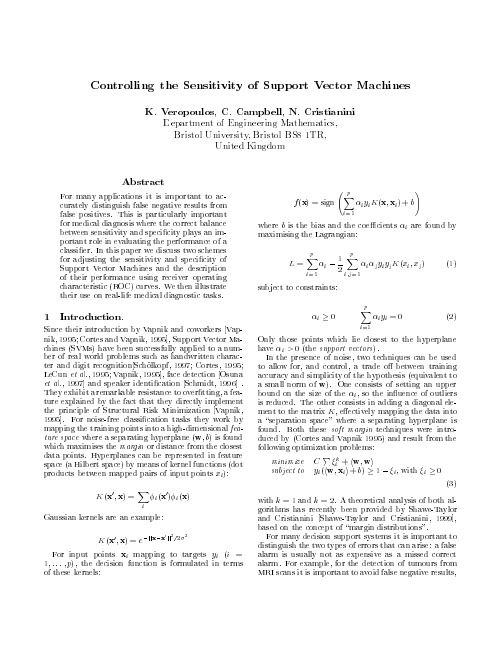
ber of real world problems such as handwritten charac-
ter and digit recognition Scholkopf, 1997; Cortes, 1995;
LeteCalu.,n1e9t9a7l].,a1n9d9s5p;eVaakperniikd,e1n9ti95c]a, tfiaocne
cients
i are found by
L = Xp
i=1
i
?
1 2
Xp
i;j=1
i
jyiyjK(xi; xj)
(1)
subject to constraints:
i0
Xp iyi = 0
(2)
i=1
Only those points which lie closest to the hyperplane
pdoeicnitssionxifumncatpiopningis
to targets formulated
yini
(i = terms
of these kernels:
f(x) = sign
Xp
!
iyiK(x; xi) + b
i=1
where b is the bias and the coe maximising the Lagrangian:
have In
thie>p0re(stehnecesuopfpnoortisve,ecttworos
). techniques
can
be
used
to allow for, and control, a trade o between training
群智能算法优化支持向量机参数综述
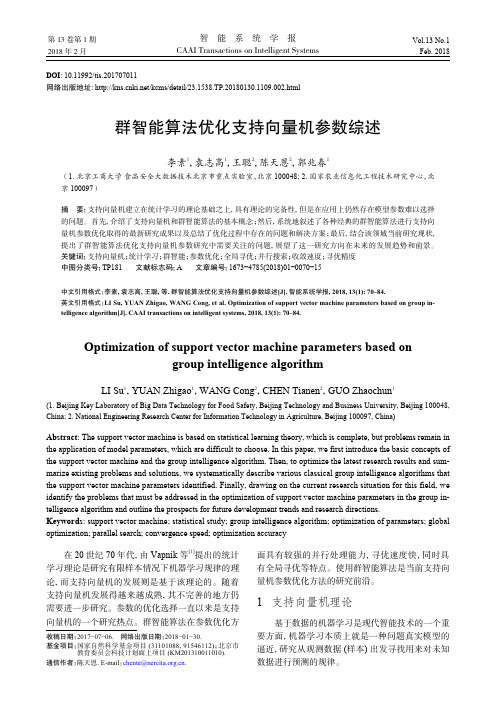
DOI : 10.11992/tis.201707011网络出版地址: /kcms/detail/23.1538.TP.20180130.1109.002.html群智能算法优化支持向量机参数综述李素1,袁志高1,王聪2,陈天恩2,郭兆春1(1. 北京工商大学 食品安全大数据技术北京市重点实验室,北京 100048; 2. 国家农业信息化工程技术研究中心,北京 100097)摘 要:支持向量机建立在统计学习的理论基础之上,具有理论的完备性,但是在应用上仍然存在模型参数难以选择的问题。
首先,介绍了支持向量机和群智能算法的基本概念;然后,系统地叙述了各种经典的群智能算法进行支持向量机参数优化取得的最新研究成果以及总结了优化过程中存在的问题和解决方案;最后,结合该领域当前研究现状,提出了群智能算法优化支持向量机参数研究中需要关注的问题,展望了这一研究方向在未来的发展趋势和前景。
关键词:支持向量机;统计学习;群智能;参数优化;全局寻优;并行搜索;收敛速度;寻优精度中图分类号:TP181 文献标志码:A 文章编号:1673−4785(2018)01−0070−15中文引用格式:李素, 袁志高, 王聪, 等. 群智能算法优化支持向量机参数综述[J]. 智能系统学报, 2018, 13(1): 70–84.英文引用格式:LI Su, YUAN Zhigao, WANG Cong, et al. Optimization of support vector machine parameters based on group in-telligence algorithm[J]. CAAI transactions on intelligent systems, 2018, 13(1): 70–84.Optimization of support vector machine parameters based ongroup intelligence algorithmLI Su 1,YUAN Zhigao 1,WANG Cong 2,CHEN Tianen 2,GUO Zhaochun 1(1. Beijing Key Laboratory of Big Data Technology for Food Safety, Beijing Technology and Business University, Beijing 100048,China; 2. National Engineering Research Center for Information Technology in Agriculture, Beijing 100097, China)Abstract : The support vector machine is based on statistical learning theory, which is complete, but problems remain in the application of model parameters, which are difficult to choose. In this paper, we first introduce the basic concepts of the support vector machine and the group intelligence algorithm. Then, to optimize the latest research results and sum-marize existing problems and solutions, we systematically describe various classical group intelligence algorithms that the support vector machine parameters identified. Finally, drawing on the current research situation for this field, we identify the problems that must be addressed in the optimization of support vector machine parameters in the group in-telligence algorithm and outline the prospects for future development trends and research directions.Keywords : support vector machine; statistical study; group intelligence algorithm; optimization of parameters; global optimization; parallel search; convergence speed; optimization accuracy在20世纪70年代,由Vapnik 等[1]提出的统计学习理论是研究有限样本情况下机器学习规律的理论,而支持向量机的发展则是基于该理论的。
Support Vector Machines and Kernel Methods
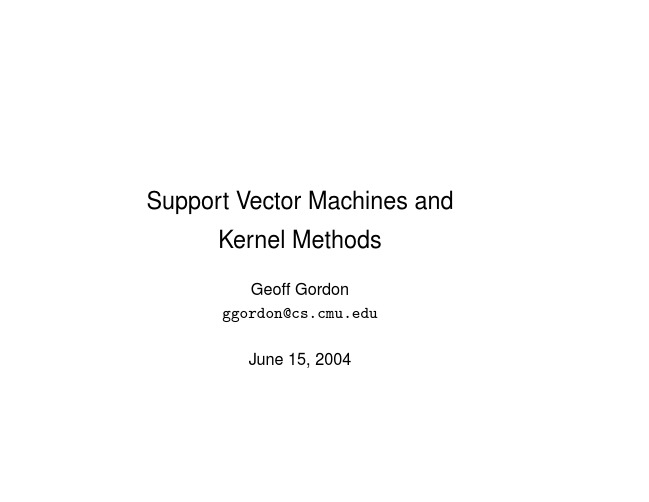
Slack variables
4 3.5 3 2.5 2 1.5 1 0.5 0 −0.5 −3
−2
−1
0
1
2
3
If not linearly separable, add slack variable s ≥ 0 y (x · w + c) + s ≥ 1 Then
i si is total amount by which constraints are violated i si as small as possible
So try to make
Perceptron as convex program
The final convex program for the perceptron is: min
i si subject to
(y i x i ) · w + y i c + s i ≥ 1 si ≥ 0 We will try to understand this program using convex duality
10 8
6
4
2
0
−2
−4
−6
−8
−10 −10
−8
−6
−4
−2
0
2
4
6
8
10
Classification problem
100
10
% Middle & Upper Class
. . .
95
8
6
90
4
85
2
80
0
75
−2
70
−4
−6
65
X
Fuzzy support vector machines
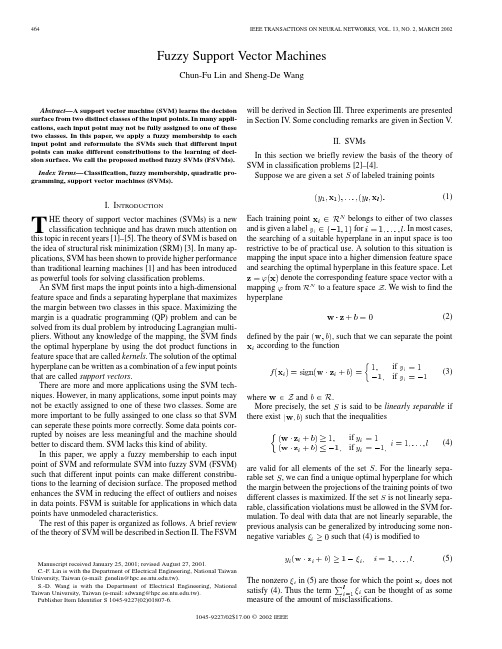
Fuzzy Support Vector Machines Chun-Fu Lin and Sheng-De WangAbstract—A support vector machine(SVM)learns the decision surface from two distinct classes of the input points.In many appli-cations,each input point may not be fully assigned to one of these two classes.In this paper,we apply a fuzzy membership to each input point and reformulate the SVMs such that different input points can make different constributions to the learning of deci-sion surface.We call the proposed method fuzzy SVMs(FSVMs). Index Terms—Classification,fuzzy membership,quadratic pro-gramming,support vector machines(SVMs).I.I NTRODUCTIONT HE theory of support vector machines(SVMs)is a new classification technique and has drawn much attention on this topic in recent years[1]–[5].The theory of SVM is based on the idea of structural risk minimization(SRM)[3].In many ap-plications,SVM has been shown to provide higher performance than traditional learning machines[1]and has been introduced as powerful tools for solving classification problems.An SVM first maps the input points into a high-dimensional feature space and finds a separating hyperplane that maximizes the margin between two classes in this space.Maximizing the margin is a quadratic programming(QP)problem and can be solved from its dual problem by introducing Lagrangian multi-pliers.Without any knowledge of the mapping,the SVM finds the optimal hyperplane by using the dot product functions in feature space that are called kernels.The solution of the optimal hyperplane can be written as a combination of a few input points that are called support vectors.There are more and more applications using the SVM tech-niques.However,in many applications,some input points may not be exactly assigned to one of these two classes.Some are more important to be fully assinged to one class so that SVM can seperate these points more correctly.Some data points cor-rupted by noises are less meaningful and the machine should better to discard them.SVM lacks this kind of ability.In this paper,we apply a fuzzy membership to each input point of SVM and reformulate SVM into fuzzy SVM(FSVM) such that different input points can make different constribu-tions to the learning of decision surface.The proposed method enhances the SVM in reducing the effect of outliers and noises in data points.FSVM is suitable for applications in which data points have unmodeled characteristics.The rest of this paper is organized as follows.A brief review of the theory of SVM will be described in Section II.The FSVMManuscript received January25,2001;revised August27,2001.C.-F.Lin is with the Department of Electrical Engineering,National Taiwan University,Taiwan(e-mail:genelin@.tw).S.-D.Wang is with the Department of Electrical Engineering,National Taiwan University,Taiwan(e-mail:sdwang@.tw).Publisher Item Identifier S1045-9227(02)01807-6.will be derived in Section III.Three experiments are presented in Section IV.Some concluding remarks are given in Section V.II.SVMsIn this section we briefly review the basis of the theory of SVM in classification problems[2]–[4].Suppose we are given asetThe optimal hyperplane problem is then regraded as the so-lution to theproblem(6)where can be regarded as aregularization parameter.This is the only free parameter in theSVM formulation.Tuning this parameter can make balance be-tween margin maximization and classification violation.Detaildiscussions can be found in[4],[6].Searching the optimal hyperplane in(6)is a QP problem,which can be solved by constructing a Lagrangian and trans-formed into thedual(7)where is the vector of nonnegative Lagrangemultipliers associated with the constraints(5).The Kuhn–Tucker theorem plays an important role in thetheory of SVM.According to this theorem,thesolution(8)in(8)are those for which the constraints(5)are satisfied with theequality sign.Thepointandis classified correctly and clearlyaway the decision margin.To construct the optimalhyperplane,it followsthat,the computationof problem(7)and(11)is impossible.There is a good propertyof SVM that it is not necessary to knowaboutcalled kernel that can compute the dotproduct of the data points in featurespace(14)and the decision functionis(15)III.FSVMsIn this section,we make a detail description about the ideaand formulations of FSVMs.A.Fuzzy Property of InputSVM is a powerful tool for solving classification problems[1],but there are still some limitataions of this theory.From thetraining set(1)and formulations discussed above,each trainingpoint belongs to either one class or the other.For each class,wecan easily check that all training points of this class are treateduniformly in the theory of SVM.In many real-world applications,the effects of the trainingpoints are different.It is often that some training points are moreimportant than others in the classificaiton problem.We wouldrequire that the meaningful training points must be classifiedcorrectly and would not care about some training points likenoises whether or not they are misclassified.That is,each training point no more exactly belongs to oneof the two classes.It may90%belong to one class and10%be meaningless,and it may20%belong to one class and80%be meaningless.In other words,there is a fuzzymembershipcan be regarded as the attitude ofmeaningless.We extend the concept of SVM with fuzzy mem-bership and make it an FSVM.B.Reformulate SVM Suppose we are given aset,and sufficientsmall denote the corresponding featurespace vector with amapping.Since the fuzzymembership is the attitude of the corre-spondingpoint(17)where(19)(22)and the Kuhn–Tucker conditions are definedas(23)is misclassi-fied.An important difference between SVM and FSVM is thatthe points with the same value ofin SVM controls the tradeoff be-tween the maximization of margin and the amount of misclassi-fications.Alargermakes SVMignore more training points and get wider margin.In FSVM,we canset(25)where,and make the firstpoint.If we want to make fuzzy membershipbe a linear function of the time,we canselect(26)By applying the boundary conditions,we cangetFig.1.The result of SVM learning for data with time property. By applying the boundary conditions,we canget(30)where(31)suchthat1,it may belongs to this class with lower accuracy or reallybelongs to another class.For this purpose,we can select thefuzzy membership as a function of respective class.Suppose we are given a sequence of trainingpointsifFig.2.The result of FSVM learning for data with time property.Fig.3shows the result of the SVM and Fig.4shows the result of FSVM bysettingis indicated as square.In Fig.3,the SVM finds theoptimal hyperplane with errors appearing in each class.In Fig.4,we apply different fuzzy memberships to different classes,theFSVM finds the optimal hyperplane with errors appearing onlyin one class.We can easily check that the FSVM classify theclass of cross with high accuracy and the class of square withlow accuracy,while the SVM does not.e Class Center to Reduce the Effects of OutliersMany research results have shown that the SVM is very sen-sitive to noises and outliners[8],[9].The FSVM can also applyto reduce to effects of outliers.We propose a model by settingthe fuzzy membership as a function of the distance between thepoint and its class center.This setting of the membership couldnot be the best way to solve the problem of outliers.We just pro-pose a way to solve this problem.It may be better to choose a dif-ferent model of fuzzy membership function in different trainingset.Suppose we are given a sequence of trainingpoints1(37)and the radius ofclassif(39)whereis indicated as square.In Fig.5,theSVM finds the optimal hyperplane with the effect of outliers,for example,a square at( 2.2).InFig.6,the distance of the above two outliers to its correspondingmean is equal to the radius.Since the fuzzy membership is afunction of the mean and radius of each class,these two pointsare regarded as less important in FSVM training such that thereis a big difference between the hyperplanes found by SVM andFSVM.Fig.3.The result of SVM learning for data sets with different weighting.Fig.4.The result of FSVM learning for data sets with different weighting.Fig.5.The result of SVM learning for data sets with outliers.Fig.6.The result of FSVM learning for data sets with outliers.V.C ONCLUSIONIn this paper,we proposed the FSVM that imposes a fuzzy membership to each input point such that different input points can make different constributions to the learning of decision sur-face.By setting different types of fuzzy membership,we can easily apply FSVM to solve different kinds of problems.This extends the application horizon of the SVM.There remains some future work to be done.One is to select a proper fuzzy membership function to a problem.The goal is to automatically or adaptively determine a suitable model of fuzzy membership function that can reduce the effect of noises and outliers for a class of problems.R EFERENCES[1] C.Burges,“A tutorial on support vector machines for pattern recogni-tion,”Data Mining and Knowledge Discovery,vol.2,no.2,1998.[2] C.Cortes and V.N.Vapnik,“Support vector networks,”MachineLearning,vol.20,pp.273–297,1995.[3]V.N.Vapnik,The Nature of Statistical Learning Theory.New York:Springer-Verlag,1995.[4],Statistical Learning Theory.New York:Wiley,1998.[5] B.Schölkopf,C.Burges,and A.Smola,Advances in Kernel Methods:Support Vector Learning.Cambridge,MA:MIT Press,1999.[6]M.Pontil and A.Verri,Massachusetts Inst.Technol.,1997,AI Memono.1612.Properties of support vector machines.[7]N.de Freitas,o,P.Clarkson,M.Niranjan,and A.Gee,“Sequen-tial support vector machines,”Proc.IEEE NNSP’99,pp.31–40,1999.[8]I.Guyon,N.Matic´,and V.N.Vapnik,Discovering Information Patternsand Data Cleaning.Cambridge,MA:MIT Press,1996,pp.181–203.[9]X.Zhang,“Using class-center vectors to build support vector machines,”in Proc.IEEE NNSP’99,1999,pp.3–11.。
用于滚动轴承故障检测与分类的支持向量机方法
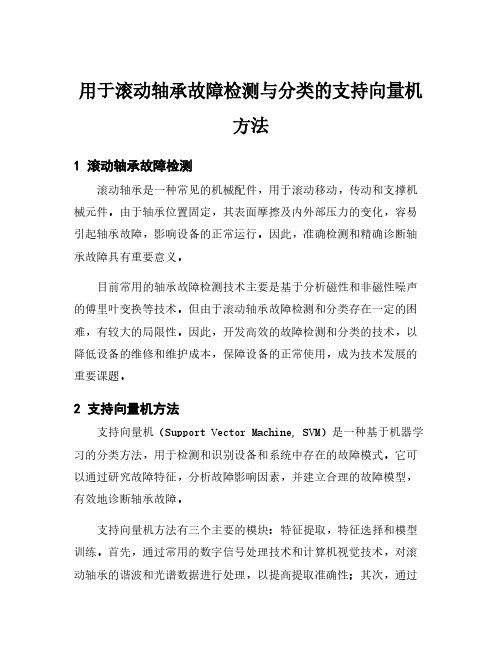
用于滚动轴承故障检测与分类的支持向量机
方法
1 滚动轴承故障检测
滚动轴承是一种常见的机械配件,用于滚动移动,传动和支撑机械元件。
由于轴承位置固定,其表面摩擦及内外部压力的变化,容易引起轴承故障,影响设备的正常运行。
因此,准确检测和精确诊断轴承故障具有重要意义。
目前常用的轴承故障检测技术主要是基于分析磁性和非磁性噪声的傅里叶变换等技术。
但由于滚动轴承故障检测和分类存在一定的困难,有较大的局限性。
因此,开发高效的故障检测和分类的技术,以降低设备的维修和维护成本,保障设备的正常使用,成为技术发展的重要课题。
2 支持向量机方法
支持向量机(Support Vector Machine, SVM)是一种基于机器学习的分类方法,用于检测和识别设备和系统中存在的故障模式。
它可以通过研究故障特征,分析故障影响因素,并建立合理的故障模型,有效地诊断轴承故障。
支持向量机方法有三个主要的模块:特征提取,特征选择和模型训练。
首先,通过常用的数字信号处理技术和计算机视觉技术,对滚动轴承的谐波和光谱数据进行处理,以提高提取准确性;其次,通过
精心设计的特征选择算法,可以高效地实现特征选择,以帮助识别及检测轴承故障;最后,运用支持向量机算法建立针对不同轴承故障的模型,用于训练模型和识别轴承故障分类。
由此可见,支持向量机方法在滚动轴承故障诊断与分类领域具有良好的性能,能够实时地检测和分析轴承故障模式,也就是说,可以有效检测和分类不同类别的滚动轴承故障。
不仅可以减少轴承故障对设备造成的不良影响,而且可以降低维护费用,提高检测效率,切实维护设备的运行安全。
SVMPPT课件
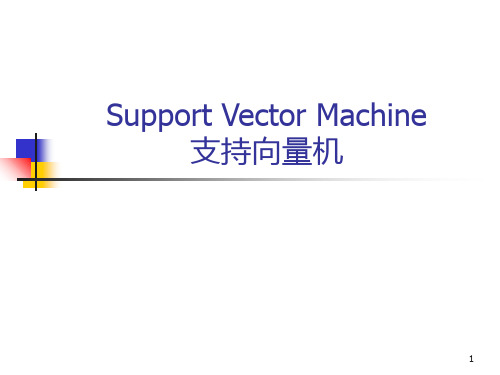
以简单的理解为问题的复杂程度,VC维越高, 一个问题就越复杂。正是因为SVM关注的是VC 维,后面我们可以看到,SVM解决问题的时候, 和样本的维数是无关的(甚至样本是上万维的 都可以,这使得SVM很适合用来解决像文本分 类这样的问题,当然,有这样的能力也因为引 入了核函数)。
11
SVM简介
置信风险:与两个量有关,一是样本数
量,显然给定的样本数量越大,我们的 学习结果越有可能正确,此时置信风险 越小;二是分类函数的VC维,显然VC维 越大,推广能力越差,置信风险会变大。
12
SVM简介
泛化误差界的公式为:
R(w)≤Remp(w)+Ф(n/h) 公式中R(w)就是真实风险,Remp(w)表示 经验风险,Ф(n/h)表示置信风险。此时 目标就从经验风险最小化变为了寻求经 验风险与置信风险的和最小,即结构风 险最小。
4
SVM简介
支持向量机方法是建立在统计学习理论 的VC 维理论和结构风险最小原理基础上 的,根据有限的样本信息在模型的复杂 性(即对特定训练样本的学习精度, Accuracy)和学习能力(即无错误地识 别任意样本的能力)之间寻求最佳折衷, 以期获得最好的推广能力(或称泛化能 力)。
5
SVM简介
10
SVM简介
泛化误差界:为了解决刚才的问题,统计学
提出了泛化误差界的概念。就是指真实风险应 该由两部分内容刻画,一是经验风险,代表了 分类器在给定样本上的误差;二是置信风险, 代表了我们在多大程度上可以信任分类器在未 知样本上分类的结果。很显然,第二部分是没 有办法精确计算的,因此只能给出一个估计的 区间,也使得整个误差只能计算上界,而无法 计算准确的值(所以叫做泛化误差界,而不叫 泛化误差)。
高维数据分类方法研究

高维数据分类方法研究一、绪论随着科技的不断进步,现代社会中高维数据越来越常见,比如图像、声音、基因等。
在这些高维数据中,如何提取有价值的信息并对其进行分类成为了研究的重点之一。
高维数据分类是机器学习中的一个研究分支,目前涌现了很多分类方法。
本文将分析目前常用的高维数据分类方法,包括传统的支持向量机、决策树、神经网络分类和近年来较为新颖的深度学习分类方法,并通过案例实例对比这些方法的优缺点,为后续的高维数据分类研究提供一定的参考。
二、传统的高维数据分类方法1. 支持向量机支持向量机(Support Vector Machine,SVM)是一种基于逻辑回归的分类器,能够被用于解决高维空间的问题。
它通过寻找一个最小化分类误差的超平面,将数据分为两个类别。
不过,SVM的分类效果往往受到数据集的特征复杂度、训练集大小等多种因素的影响。
2. 决策树在传统的高维数据分类方法中,决策树也被广泛应用。
决策树(Decision Tree)是一种常用的分类算法,用于解决多分类问题。
在决策树分类中,将数据分为不同的类别时,策略是根据数据的特征,逐步构造由节点和边组成的树形结构。
然而,决策树分类方法存在“过拟合”的问题,建立的分类模型容易受到噪点的影响。
3. 神经网络分类神经网络分类(Neural Network Classificaion)是利用神经网络模型实现的分类方法。
神经网络分类能够高性能地分类和识别数据,并对数据执行高维度转换。
然而,神经网络分类方法需要大量的计算资源,而且很难确定合适的神经网络的结构、层数和参数。
三、深度学习分类方法随着计算机硬件的不断提升和深度学习框架的发展,深度学习分类方法逐渐成为了高维数据分类领域的主流。
深度学习通过堆叠多个神经网络层来学习数据的特征。
下面将对深度学习分类常用的卷积神经网络(CNN)和循环神经网络(RNN)进行分析。
1. 卷积神经网络卷积神经网络(Convolutional Neural Network, CNN)是一种数据挖掘技术,可用于图像分类、视频分类等领域。
Support Vector MachinesSupport Vector Machines
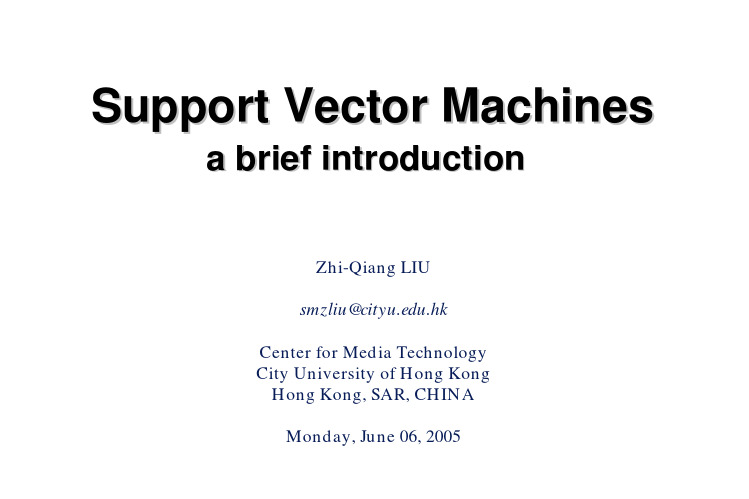
Support Vector Machinesa brief introduction刘志强Zhi-Qiang LIUsmzliu@.hkCenter for Media TechnologyCity University of Hong KongHong Kong, SAR, CHINAMonday, June 06, 2005Outline:•Linear classification:–separable cases–inseparable cases•Nonlinear classification•Two major concepts:–Maximum margin for the separating hyperplane;–Mapping input samples to a (higher dimensional)feature space.SVM Landmark Development Early Days•1963 V. Vapnik, V., A. Lerner, their pioneering work on Statistical learning theory•1965, 1968 O. Mangasarian’s work on optimization •1971 G. Kimeldorf, G and G.Wahba, on non-parametric regressionSVM Landmark Development Since 90s •Since early 1990s, we have seen renewed interest in themachine learning community which was led by–V. Vapnik, B. Boser; Guyon, I.; K. Bennett; O. Mangasarian,•1995 C. Cortes, Learning Theory–soft margin classifier–effective VC-dimensions,–other formalisms.The Learning Task and Problems The general task machine learning for patternrecognition, data-mining, and data analysis etc. is tolook for complex patterns in data (using clustering or classification).Two common problems:•Computational problem: How to represent complex patterns?and•Statistical problem: How to avoid overfitting by excluding spurious (unstable) patterns?Linear Methods:Common CharacteristicWhat is the common characteristic among the following statistical methods?1.Ridge regression2.Fisher discriminant analysis3.Principal Components Analysis4.Canonical correlation analysisRidge Regression221min ()||||T w i i i yw x w λ=−+∑A regularization target problem:input 1111()()(),T T d T T Tij i j i i i w X X I X yX XXI y X G I y G x x x λλλα−−−==+=+=+=<>=∑A A A dxd inverse inverse ×A A solution:Dual RepresentationLinear CombinationsObservation:They contain linear combinations of input vectors of the form:•Linear algorithms are very well understood and enjoy good properties: convexity, generalization bounds).•Can we carry these properties over to non-linear algorithms? But let’s look at some linear cases first.〉〈==x w x w x f ,)(TLinear DiscriminantsLet’s consider the simplest linear classifier, Perceptron:xf−=sign⋅x)w()(bThe input data, x i, i =1,…,n,have labels y i= -1 or +1How to find the best hyperplane ?ni x d x c d c i y i y ii y i iy i i i i i ,...,1 ,0 ,1 , 1such that ,where ||||211class 1class 1-class 1class 2min =≥====−∑∑∑∑+∈+∈∈+∈ααααααThe classic approachSupport Vector: Max Margin Approach.1)( simply,or 1,Class ,11Class ,1such that ||||212,min ≥−⋅−∈−≤⋅+∈+≥⋅b x w y y b x w y b x w w i i i i i i bw The dashed lines arethe supporting planes which Touch their corresponding Support Vectors .This is commonly known as the Primal form.Support Vector Machine:Duality propertyni y x x y y i ni ii ni i j i j i j ni nj i ,...,2,1 ,0 ,0such that21min 1111=≥=⎥⎦⎤⎢⎣⎡−⋅∑∑∑∑====ααααααFor detailed derivation, see The Statistical Learning Theory , V. Vapnik, 1998Linear discriminant:separable cases+++++++++wx+ b=0Linear discriminant:the Max Margin++++++wx+ b=0Linear discriminant:the separable caseLinear discriminant:the Max MarginLinear discriminant:the Max Margin++++++wx+ b=022min1maxwwMargin•Margin is the minimum distance to the plane of any point.•Principle: from the hyperplanes that separate the data perfectly ,pick the one that maximizes the margin,•Since the scale is arbitrary, the value of the margin can be set to 1.•Now maximizing the margin is equivalent to picking the separating hyperplane that minimizes the norm of the weight vector:1)( subject to ||||2≥+⋅b x w y w i i 2||||1w•In high dimensional feature spaces we are able to define complex functions; however,•It computationally intractable for many real-world applications (due huge vectors);•A generalization problem (the curse of dimensionality).SVMs work with Kernels •Solves the computational problem in high dimensions.•Robust performance.Two Major TheoremsThere are two important theorems that are considered the corner stones of the SVM enterprise:–The Karush-Kuhn-Tucker Theorem which givestheoretical guidelines for practical implimentation and analysis;–Mercer’s Theorem which establishes the condition for proper kernels.Mercer ’s Theorem () )()(),(and )()(),( such that then 0)()(),( ,definite positive of function a be ),(Let 1,12y x y x K y dx x y x K dxdy y g x f y x K g f L y x K k k k k k k k k k ϕϕλϕλϕϕ∑∫∫∫∞=∞===∃≥∀This implies that the eigenfunctions are regarded as features.What Mercer really meant?Mercer’s theorem says that•The kernel matrix is Symmetric Positive Definite.•Any symmetric positive definite matrix can be regarded as a kernel matrix, that is, as an inner product matrix in some space.Duality: the First Property of SVMs As we have seen last week, it is possible represent a linear classification problem in its dual form.–Duality is the first feature of SVMs,–Data appear only in dot products.The Second Property of SVMs SVMs are linear learning machines, that •use a dual representation, and •operate in a kernel induced feature space.SVM: the Generalization Problem •Generalization is the ability of a hypothesis to correctly classify data not seen in the training set.•Due to the curse of dimensionality, it is easy to overfit in high dimensional spaces.•The SVM problem is ill posed: many hyperplanes exist—no unique solution;•Briefly, statistical learning proves that bounds on the generalization error on future data can be obtained, which are a function of misclassification error on the training data and terms that measure the complexity or capacity of theclassification function.Margin and Generalization•In general, maximizing the margin will minimizing bounds on generalization error, hence better generalization with a higher probability.•Since the size of the margin is not directly dependent on the dimensionality of the data, we may obtain good performance even for very high-dimensional data.•Consequently, problems caused by overfitting of high-dimensional date are greatly reduced.Importance of MarginsFewer possibilities Many possibilitiesComplexity and Capacity•Narrower margins make it more capable and flexible in fitting the data, therefore more complex;•Wider (fatter) margins are less flexible and simple.•Usually the complexity of a linear function is related to the number of variables.That is,•By maximizing the margin, we can control the complexity of the model and improve generalization.The Overfitting ProblemLearning requires to test as wide as possible a range of hypotheses, while making as few assumptions as possible.–Too restrictive will lead to underfitting, e.g., Gaussianassumption for non-Gaussian data.–Too few assumptions leave too much flexibity(e.g., by allowing too rich a set of hypotheses) such that everything goes: therewill always a fit. This is the overfitting problem.–We must make use of all known facts about the data, e.g.,eliciting expert knowledge.The Overfitting Problem(a)(b)(c)Given only a small number of samples (a) either the solid or the dashedhypothesis might be true. Given a large number of samples, it is possible to reach a reasonable decision. However, we may still have some problems: If the dashed hypothesis is correct the solid would underfit(b); whereas if the solid were true the dashed hypothesis would overfit(c).(from AN INTRODUCTION TO KERNEL-BASED LEARNING ALGORITHMS IEEE TNN 2001)Limitations of Linear Discriminants Linear classifiers are straightforward, but cannot deal with non-linearly separable data and noisy data that may make the classifier less robust.How to bisect the two sets withoverlapping convex hulls?Reduced Convex Hull•For such cases we need to modify the notion of convex null (I assume you know) by restricting the influence of each point •This results in the so-called reduced convex hulls by introducing an upper bound D<1 which is sufficiently small to not intersect. Formally,D x d i Class y i Class y i i i i ≤≤==∑∑+∈+∈ααα0 ,1 where 11Reduced Convex HullNow the linear plane can bisect the datasets,but a point has been wrongly classified.Select a plane to maximize the margin and minimize error. But we also want no data that are misclassified.Regularization•This can be accomplished by adding a constraint asfollows:which leads to the followingFor detailed derivation, see The Statistical Learning Theory , V. Vapnik, 1998ni z z b x w y z w i i i i n i i z b w ,...,1 ,0 ,1)(such that||||21min 12,,=≥≥+−⋅+∑=λni y x x y y i n i i in i i j i j i j n i n j i ,...,2,1 ,0 ,0such that 21min 1111=≥≥=⎥⎦⎤⎢⎣⎡−⋅∑∑∑∑====αλαααααUnique and Sparse •This is a quadratic programming problem. Since it is convex, it’s the unique solution.•It is also sparse as only the training points nearest to the separating hyperplane (i.e., with margin=1) have i >0. These points are the “active” points, or the support vectors,since the final weight vector depends only on them:i i i i x y w ∑=α*•This is a lucky coincidence: in the case of SVM classification the two goals of controlling overfitting and inducing sparsity can both be achieved simultaneously with only a single trick: maximum margin (or minimum weight norm).•But this is not in general true.The Essence of SVM•An SVM is a kernelized maximum-margin hyperplane classier.•It is trained by solving the dual quadratic programming (QP) problem.•It is evaluated by the kernel function between the test points and each of the “active” training points called support vectors.•SVM is effective due to the following reasons:–the kernel trick,–maximum margin (minimum norm), and–the resulting sparsity.•From a computational point of view it is solving the large QP efficiently.•However, in practice, it is difficult to select the kernel function (a major research topic in SVM).Non-Linear DiscriminantTwo possible approaches:1.Constructing a neural network (problems: localminima; many parameters; heuristics needed to train; etc)2.Mapping data into a richer feature spaceincluding non-linear features, then use a linearclassifier.Non-linear Discriminant•For linear discriminant functions, the basic principle of SVM is to construct max margin separating plane.•In this way SVM can construct linear classification functions with good theoretical and practical generalization properties even in very high-dimensional feature spaces.•However for nonlinear cases, SVM must be extended by using kernels.A Quadratic ExampleIn such a case we need at least a quadratic discrimintion function.Quadratic ExampleIn a 2D space we may define circle as follows:.)(havewe space, feature In the},,,,{)(:operation following by the generated},,,,{:features five need we circle a for },{2524321222221s w r w rs w s w r w x w s r rs s r x s r rs s r sw r w x w s r x ++++=⋅=+=⋅=φφ).())(()(is,That 2524321s w r w rs w s w r w sign b x w sign x f ++++=−⋅=φBut SVM uses the kernel trickto get around the high dimensionality problem.Quadratic Example: use KernelThis increase of dimension has two potential problems:–Overfitting;–It’s not practical to actually compute φ(x).SVM gets around these problems through the use of kernel.Quadratic Example: use KernelLet nN R R x Nn >>→ ,:)(φmi y x x k y y x x y y i mi ii m i i j i j i j m i m j i m i i j i j i j m i m j i ,...,2,1 ,0 ,0such that),(21min )()(21min 1111111=≥≥=⎥⎦⎤⎢⎣⎡−=⎥⎦⎤⎢⎣⎡−⋅∑∑∑∑∑∑∑=======αλαααααφφααααSummary: Benefits of Kernels•It can be seen that to change from a linear classifier, we need only to substitute a kernel in the objective (or cost or penalty) function.•In this way we can design highly non-linear classifiers.•No algorithmic changes are needed.•All benefits of the original linear SVM method are maintained.•By using kernel, we can handle nonlinear classifiers easily.Applications•On-line handwritten Character recognition •Face detection and recognition•Text mining•Genomic DNA sequence analysis •Information retrieval•Structural pattern recognition (since 1999), etc.•Optimization:–Vapnik–Osuna, E. & Girosi,–John C. Platt–Linda Kaufman–Thorsten JoachimsSome Open Problems•VC Entropy for Margin Classifiers: learning bounds;•Other margin classifiers: boosting;•Non L2(quadratic) cost functions: Sparse coding (Drezet and Harrsion);•Curse of dimensionality: local vs global kernel influence (Tsuda);•Selection of kernels.References on SVMV. Vapnik,1.The Nature of Statistical Learning Theory. Springer-Verlag, 1995,2.Statistical Learning Theory. Wiley, 1998.V. Cherkassky and F. Mulier,•Learning from Data: Concepts, Theory, and Methods. Wiley, 1998.C.J.C. Burges,•“A tutorial on support vector machines for pattern recognition,”Data Mining and Knowledge, Discovery, Vol. 2 No. 2, 1998.。
基于支持向量机的长波红外目标分类识别算法
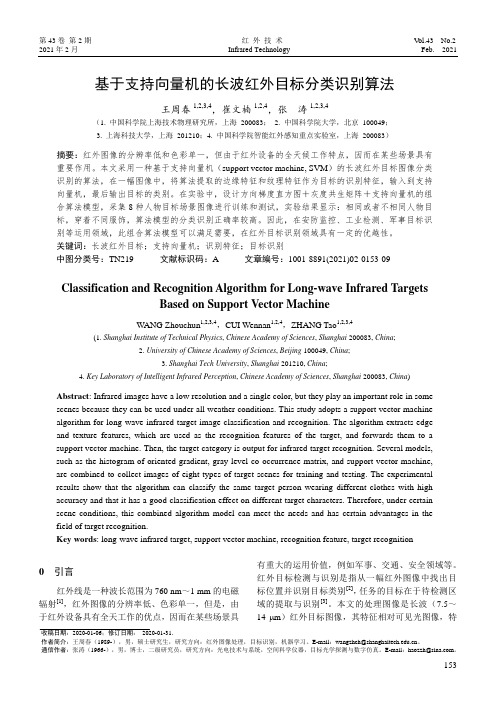
基于支持向量机的长波红外目标分类识别算法王周春1,2,3,4,崔文楠1,2,4,张涛1,2,3,4(1. 中国科学院上海技术物理研究所,上海 200083; 2. 中国科学院大学,北京 100049;3. 上海科技大学,上海 201210;4. 中国科学院智能红外感知重点实验室,上海 200083)摘要:红外图像的分辨率低和色彩单一,但由于红外设备的全天候工作特点,因而在某些场景具有重要作用。
本文采用一种基于支持向量机(support vector machine, SVM)的长波红外目标图像分类识别的算法,在一幅图像中,将算法提取的边缘特征和纹理特征作为目标的识别特征,输入到支持向量机,最后输出目标的类别。
在实验中,设计方向梯度直方图+灰度共生矩阵+支持向量机的组合算法模型,采集8种人物目标场景图像进行训练和测试,实验结果显示:相同或者不相同人物目标,穿着不同服饰,算法模型的分类识别正确率较高。
因此,在安防监控、工业检测、军事目标识别等运用领域,此组合算法模型可以满足需要,在红外目标识别领域具有一定的优越性。
关键词:长波红外目标;支持向量机;识别特征;目标识别中图分类号:TN219 文献标识码:A 文章编号:1001-8891(2021)02-0153-09Classification and Recognition Algorithm for Long-wave Infrared TargetsBased on Support Vector MachineWANG Zhouchun1,2,3,4,CUI Wennan1,2,4,ZHANG Tao1,2,3,4(1. Shanghai Institute of Technical Physics, Chinese Academy of Sciences, Shanghai 200083, China;2. University of Chinese Academy of Sciences, Beijing 100049, China;3. Shanghai Tech University, Shanghai 201210, China;4. Key Laboratory of Intelligent Infrared Perception, Chinese Academy of Sciences, Shanghai 200083, China)Abstract: Infrared images have a low resolution and a single color, but they play an important role in some scenes because they can be used under all weather conditions. This study adopts a support vector machine algorithm for long-wave infrared target image classification and recognition. The algorithm extracts edge and texture features, which are used as the recognition features of the target, and forwards them to a support vector machine. Then, the target category is output for infrared target recognition. Several models, such as the histogram of oriented gradient, gray level co-occurrence matrix, and support vector machine, are combined to collect images of eight types of target scenes for training and testing. The experimental results show that the algorithm can classify the same target person wearing different clothes with high accuracy and that it has a good classification effect on different target characters. Therefore, under certain scene conditions, this combined algorithm model can meet the needs and has certain advantages in the field of target recognition.Key words: long-wave infrared target, support vector machine, recognition feature, target recognition0引言红外线是一种波长范围为760nm~1mm的电磁辐射[1],红外图像的分辨率低、色彩单一,但是,由于红外设备具有全天工作的优点,因而在某些场景具有重大的运用价值,例如军事、交通、安全领域等。
基于支持向量机的蛋白质相互作用识别
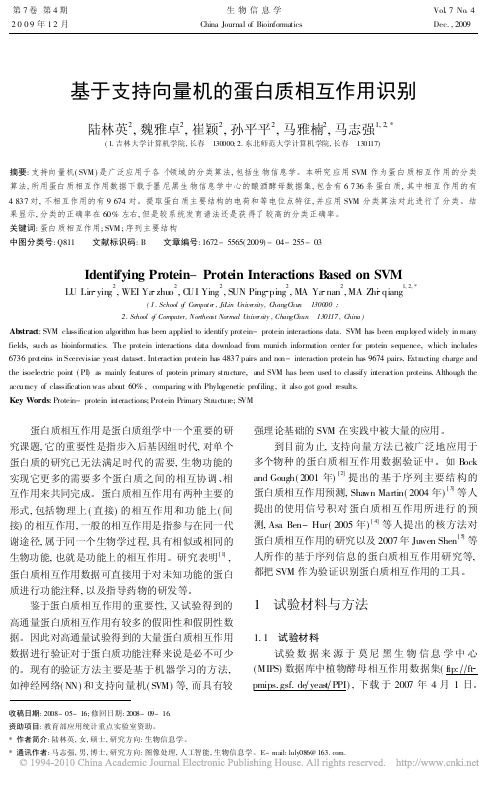
9. 808 837
6. 201 904 - 12. 370 1
5. 470 272
- 18. 243 6
8. 706 207
6. 855 703
5. 250 895
- 18. 303 7
7. 836 708
019 556
10. 736 93
7. 964 656
4. 753 734 - 43. 899 4
鉴于蛋白质相互作用的重要性, 又试验得到的 高通量蛋白质相互作用有较多的假阳性和假阴性数 据。因此对高通量试验得到的大量蛋白质相互作用 数据进行验证对于蛋白质功能注释来说是必不可少 的。现有的验证方法主要是基于机器学习的方法, 如神经网络( NN) 和支持向量机( SVM) 等, 而具有较
强理论基础的 SVM 在实践中被大量的应用。 到目前为止, 支持向量方法已被广泛地应用于
11. 815 58
5. 707 153
- 3. 469 41
5. 012 194 - 42. 406 3
5. 838 732
- 22. 535
4. 360 884 - 54. 958 4
5. 168 449
- 7. 857 95
4. 768 333 - 6. 888 71
9. 677 191
15. 305 98
SVM 最初是由 AT&T 贝尔实验室开发的, 原始 的思想是基于最大化两类样本的距离来创建一个线 性可分的分类器[7] , 它的训练目标是找到一个具有 最大间隔的分隔平面。然而原始的数据一般都比较 粗糙, 而不能 被线性可分, SVM 应用了两个技 术来 处理这个问题。首先, 使用了一个加有罚分函数的 超平面。其次把原始输入空间映射到高维度的特征 空间中, 在这个高维度的空间中找到一个能被超平 面分割的分界面。
基于支持向量机的弗兰克-赫兹实验曲线拟合

本期推荐本栏目责任编辑:王力基于支持向量机的弗兰克-赫兹实验曲线拟合周祉煜1,孟倩2(1.河北师范大学物理学院,河北石家庄050024;2.江苏师范大学计算机科学与技术学院,江苏徐州221116)摘要:弗兰克-赫兹实验是“近代物理实验”中的重要实验之一,数据量大且数据处理复杂。
支持向量机是一种广泛应用于函数逼近、模式识别、回归等领域的机器学习算法。
本文将支持向量机算法应用于弗兰克-赫兹实验数据的拟合,过程简单,在python 环境下验证该方法拟合精度高,效果好。
支持向量机算法还可应用于其他的物理实验曲线拟合。
关键词:支持向量机;曲线拟合;弗兰克-赫兹实验;Python 中图分类号:TP18文献标识码:A文章编号:1009-3044(2021)13-0001-02开放科学(资源服务)标识码(OSID ):Curve Fitting of Frank Hertz Experiment Based on Support Vector Machine ZHOU Zhi-yu 1,MENG Qian 2(1.Hebei Normal University,College of physics.,Shijiazhuang 050024,China;2.School of Computer Science and technology,Jiang⁃su Normal University,Xuzhou 221116,China)Abstract:Frank-Hertz experiment is a classical experiment in modern physics experiments.It has a large amount of experimental data and a complicated data processing process.Support Vector Machine is a machine learning algorithm which widely used in function approximation,pattern recognition,regression and other fields.In this paper,support vector machine is used to do curve fitting for the experimental data of Frank-Hertz experiment.The process is simple,and the method is verified to have high curve fit⁃ting accuracy and good effect in python environment.SVM can also be applied to curve fitting in other physics experiments.Key words:support vector machine,curve fitting,Frank Hertz experiment ,python 1998年,Vapnik V N.等人[1]提出了一种新型的基于小样本和统计学习理论的机器学习方法-支持向量机(Support Vector Machine,SVM),该方法可以从有限的训练样本出发寻找“最优函数规律”,使它能够对未知输出作尽可能准确的预测,可应用于函数逼近、模式识别、回归等领域。
Text Categorization with Support Vector Machines
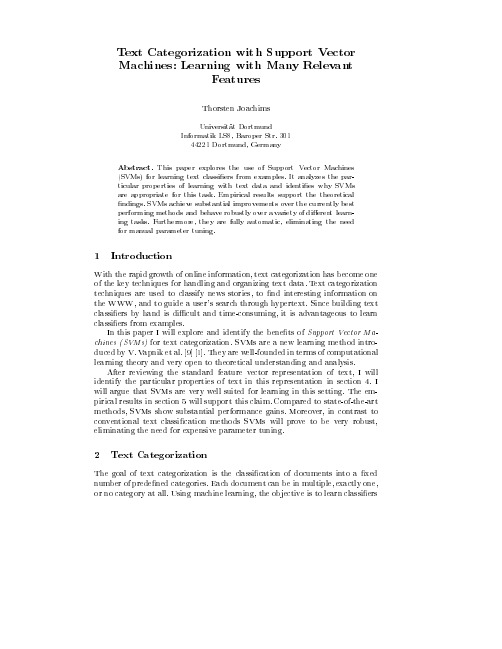
Features
Thorsten Joachims
Universitat Dortmund Informatik LS8, Baroper Str. 301
3 Support Vector Machines
Support vector machines are based on the Structural Risk Minimization principle 9 from computational learning theory. The idea of structural risk minimization is to nd a hypothesis h for which we can guarantee the lowest true error. The true error of h is the probability that h will make an error on an unseen and randomly selected test example. An upper bound can be used to connect the true error of a hypothesis h with the error of h on the training set and the complexity of H measured by VC-Dimension, the hypothesis space containing h 9 . Support vector machines nd the hypothesis h which approximately minimizes this bound on the true error by e ectively and e ciently controlling the VC-Dimension of H.
支持向量机
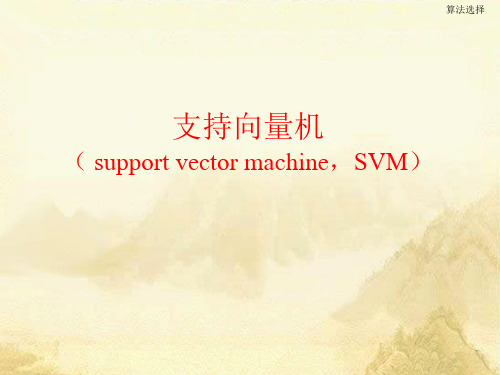
结 论: 唯一能确定得到的是真酒样本,故确定为单类分类问题,并 采用多个单类分类器分解问题的策略。
单类分类器分类:
基于概率密度的方法(Density-based classifiers) 基于神经网络的方法(ANN-based classifiers) 基于支持域的方法(Domain-based classifiers) 基于聚类的方法(Clustering-based classifiers)
软件包功能:
支持多个平台,可以在windows(命令行环境)、java、matlab 中运行,其中包括的分类器有 C-SVC 、nu-SVC、one-class SVM、 epsilon-SVR、nu-SVR,可以进行分类或者回归以及参数优选。
基本思想:通过对目标数据的学习,形成一个围绕目标的边界或区域, 如超球面、超平面等,并最小化数据支撑域的体积,已达到错误接受 率最小的目的。
优 点:由于借鉴了SVM的最大间隔理论,因而适合处理小样本、 高维和存在噪声数据的单类分类问题,代表方法有One-class SVM和 SVDD(Support Vector Data Description).
One-class SVM
算法基本原理:
给定训练数据集D,将其从RN到某高维特征空间 的非线性映射 使得
(Xi ) ,在高维空间建立一个超平面 W (x) 0 将映射样本与原点以间
隔 分开,其中w为超平面的法向量,为超平面的截距,为了使超平面尽可能
远离原点,最大化原点到目标数据间的欧氏距离 / W 来寻找最优超平面。经 过映射后的OCSVM在二维空间中寻找最优超平面。
支持向量机在脑机接口中的应用案例解析

支持向量机在脑机接口中的应用案例解析脑机接口(Brain-Computer Interface,BCI)作为一种新兴的技术,旨在通过直接连接人脑和外部设备,实现人脑与计算机之间的直接交互。
在BCI技术的发展中,支持向量机(Support Vector Machine,SVM)作为一种强大的机器学习算法,被广泛应用于脑机接口的数据处理和分类任务中。
一、脑机接口的基本原理脑机接口技术基于人脑神经活动的电信号,通过采集、处理和解读这些信号,实现人脑与外部设备之间的交互。
其基本原理是通过电极阵列或功能磁共振成像等方式,采集到人脑的神经信号,然后通过信号处理和特征提取等方法,将这些信号转化为计算机可以理解的指令,从而实现与外部设备的交互。
二、支持向量机的基本原理支持向量机是一种监督学习算法,其基本原理是通过找到一个最优超平面,将不同类别的样本点分隔开。
其核心思想是将样本点映射到高维空间中,使得样本点在高维空间中线性可分。
然后通过最大化超平面与最近的样本点之间的间隔,找到一个最优的分类边界。
三、支持向量机在脑机接口中的应用案例1. 脑机接口的信号分类在脑机接口中,支持向量机被广泛应用于对脑电信号进行分类的任务中。
通过采集到的脑电信号,可以将其转化为特征向量,并通过支持向量机进行分类。
例如,研究人员可以通过采集到的脑电信号,将其转化为频率特征、时域特征等,并利用支持向量机对这些特征进行分类,从而实现对不同脑电模式的识别。
2. 脑机接口的运动控制支持向量机还可以应用于脑机接口中的运动控制任务。
通过采集到的脑电信号,可以识别出用户的意图,进而控制外部设备的运动。
例如,研究人员可以通过支持向量机对脑电信号进行分类,将其转化为不同的运动命令,从而实现对机器人手臂的控制。
3. 脑机接口的情感识别除了运动控制,支持向量机还可以应用于脑机接口中的情感识别任务。
通过采集到的脑电信号,可以识别出用户的情感状态,从而实现情感交互。
请简述 SVM(支持向量机)的原理以及如何处理非线性问题。

请简述 SVM(支持向量机)的原理以及如何处理非线性问题。
支持向量机(Support Vector Machine,SVM)是一种常用的机器学习算法,常用于分类和回归问题。
它的原理是基于统计学习理论和结构风险最小化原则,通过寻找最优超平面来实现分类。
SVM在处理非线性问题时,可以通过核函数的引入来将数据映射到高维空间,从而实现非线性分类。
一、SVM原理支持向量机是一种二分类模型,它的基本思想是在特征空间中找到一个超平面来将不同类别的样本分开。
具体而言,SVM通过寻找一个最优超平面来最大化样本间的间隔,并将样本分为两个不同类别。
1.1 线性可分情况在特征空间中,假设有两个不同类别的样本点,并且这两个类别可以被一个超平面完全分开。
这时候我们可以找到无数个满足条件的超平面,但我们要寻找具有最大间隔(Margin)的超平面。
Margin是指离超平面最近的训练样本点到该超平面之间距离之和。
我们要选择具有最大Margin值(即支持向量)对应的决策函数作为我们模型中使用。
1.2 线性不可分情况在实际问题中,很多情况下样本不是线性可分的,这时候我们需要引入松弛变量(Slack Variable)来处理这种情况。
松弛变量允许样本点处于超平面错误的一侧,通过引入惩罚项来平衡Margin和错误分类的数量。
通过引入松弛变量,我们可以将线性不可分问题转化为线性可分问题。
同时,为了防止过拟合现象的发生,我们可以在目标函数中加入正则化项。
1.3 目标函数在SVM中,目标函数是一个凸二次规划问题。
我们需要最小化目标函数,并找到最优解。
二、处理非线性问题SVM最初是用于处理线性可分或近似线性可分的数据集。
然而,在实际应用中,很多数据集是非线性的。
为了解决这个问题,SVM引入了核函数(Kernel Function)。
核函数可以将数据从低维空间映射到高维空间,在高维空间中找到一个超平面来实现非线性分类。
通过核技巧(Kernel Trick),SVM 可以在低维空间中计算高维空间中样本点之间的内积。
基于双谱的射频指纹提取方法

第19卷 第1期 太赫兹科学与电子信息学报Vo1.19,No.1 2021年2月 Journal of Terahertz Science and Electronic Information Technology Feb.,2021文章编号:2095-4980(2021)01-0107-05基于双谱的射频指纹提取方法贾济铖,齐琳(哈尔滨工程大学信息通信工程学院,黑龙江哈尔滨 150001)摘 要:研究了基于通信辐射源射频指纹(RFF)的同类型设备分类识别理论,通过提取通信信号的围线积分双谱值来作为设备个体识别的特征向量,使用支持向量机(SVM)分类器进行识别。
构建辐射源识别系统,并使用实测信号进行仿真测试。
结果显示该方法具有稳定的识别效果,且在信噪比(SNR)为-22 dB时,系统可以达到接近90%的分类识别准确度。
这说明本文提出的基于双谱的RFF提取方法有效。
关键词:物理层安全;射频指纹;围线积分双谱;个体识别中图分类号:TN918文献标志码:A doi:10.11805/TKYDA2019291RF fingerprint extraction method based on bispectrumJIA Jicheng,QI Lin(College of Information and Communication Engineering,Harbin Engineering University,Harbin Helongjiang 150001,China)Abstract:The classification and recognition theories of the same type of equipment based on the Radio Frequency Fingerprint(RFF) of the communication radiation source are studied. The integralbispectrum values of the communication signal are extracted as the feature vector of the device, and theSupport Vector Machine(SVM) classifier is used for identification. After constructing a radiation sourceidentification system, the measured signals are used for simulation testing. The simulation results show astable recognition effect by using the proposed method, and the system can achieve nearly 90%classification recognition accuracy when the Signal to Noise Ratio(SNR) is -22 dB. This result validatesthe effectiveness of bispectrum-based RF fingerprint extraction method.Keywords:physical layer security;Radio Frequency Fingerprint(RFF);contour integral bispectrum;individual identification物联网及5G的快速发展,使彼此链接的无线设备越来越多,同时也带来了一系列监管与安全的难题。
遥感图像解译中的支持向量机分类算法研究
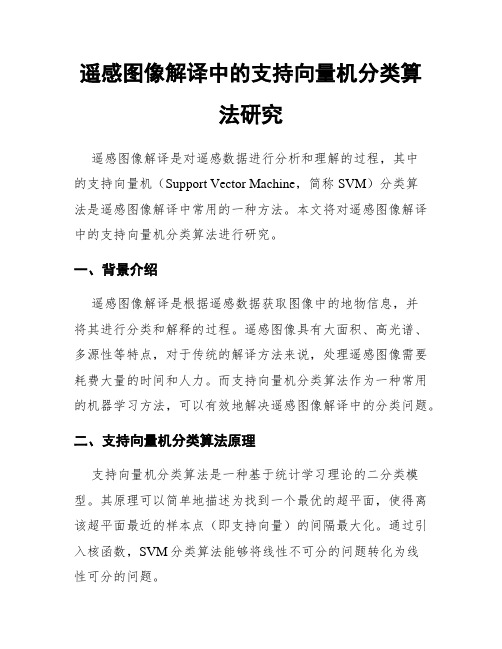
遥感图像解译中的支持向量机分类算法研究遥感图像解译是对遥感数据进行分析和理解的过程,其中的支持向量机(Support Vector Machine,简称SVM)分类算法是遥感图像解译中常用的一种方法。
本文将对遥感图像解译中的支持向量机分类算法进行研究。
一、背景介绍遥感图像解译是根据遥感数据获取图像中的地物信息,并将其进行分类和解释的过程。
遥感图像具有大面积、高光谱、多源性等特点,对于传统的解译方法来说,处理遥感图像需要耗费大量的时间和人力。
而支持向量机分类算法作为一种常用的机器学习方法,可以有效地解决遥感图像解译中的分类问题。
二、支持向量机分类算法原理支持向量机分类算法是一种基于统计学习理论的二分类模型。
其原理可以简单地描述为找到一个最优的超平面,使得离该超平面最近的样本点(即支持向量)的间隔最大化。
通过引入核函数,SVM分类算法能够将线性不可分的问题转化为线性可分的问题。
三、支持向量机分类算法在遥感图像解译中的应用1. 特征提取在遥感图像解译中,支持向量机分类算法通常需要先进行特征提取。
通过对遥感图像进行预处理和特征选择,可以提取出与地物分类相关的特征,并降低特征空间的维度。
常见的特征包括光谱信息、纹理特征、形状特征等。
2. 训练样本选择与标注支持向量机分类算法需要大量的训练样本来建立分类模型。
在遥感图像解译中,训练样本的选择和标注是至关重要的步骤。
通常采用人工选择样本,并通过专业人员对样本进行标注,确保训练样本的质量和代表性。
3. 模型训练与参数优化支持向量机分类算法需要调整模型的参数以提高分类准确度。
通过交叉验证等方法,可以选择最优的参数组合并进行模型训练。
参数优化是支持向量机算法的关键步骤,不同参数的选择会直接影响分类结果的准确性。
4. 分类结果评估与应用支持向量机分类算法通过将遥感图像像元与已知类别的样本进行分类,得到分类结果。
对分类结果进行评估可以衡量分类准确性,并对结果进行可视化展示。
support vector machine for histogram-based image classification

IEEE TRANSACTIONS ON NEURAL NETWORKS,VOL.10,NO.5,SEPTEMBER19991055 Support Vector Machines forHistogram-Based Image ClassificationOlivier Chapelle,Patrick Haffner,and Vladimir N.VapnikAbstract—Traditional classification approaches generalizepoorly on image classification tasks,because of the highdimensionality of the feature space.This paper shows thatsupport vector machines(SVM’s)can generalize well on difficultimage classification problems where the only features arehigh dimensional histograms.Heavy-tailed RBF kernels ofthe form K(x;y)=e00y jPublisher Item Identifier S1045-9227(1056IEEE TRANSACTIONS ON NEURAL NETWORKS,VOL.10,NO.5,SEPTEMBER 1999bythesolution of the maxi-mization problem (3)has been found,theOSHhas the followingexpansion:(4)The support vectors are the points forwhichwith(6)to allow the possibility of examples that violate (2).The purpose of thevariablesis chosen by the user,alargerin (7),the penalty termfor misclassifications.When dealing with images,most of the time,the dimension of the input space is large(has in this case little impact on performance.C.Nonlinear Support Vector MachinesThe input data is mapped into a high-dimensional feature space through some nonlinear mapping chosen a priori [8].In this feature space,the OSH is constructed.If wereplace ,(3)becomesisneeded in the training algorithm and themappingsuchthatsatisfying Mercer’s condition has beenchosen,the training algorithm consists ofminimizing(8)and the decision functionbecomeshyperplanes areconstructed,wheredecisionfunctionsis givenby ,i.e.,the class withthe largest decision function.We made the assumption that every point has a single label.Nevertheless,in image classification,an image may belong to several classes as its content is not unique.It would be possible to make multiclass learning more robust,and extend it to handle multilabel classification problems by using error correcting codes [12].This more complex approach has not been experimented in this paper.III.T HE D ATAAND I TSR EPRESENTATIONAmong the many possible features that can be extracted from an image,we restrict ourselves to ones which are global and low-level (the segmentation of the image into regions,objects or relations is not in the scope of the present paper).CHAPELLE et al.:SVM’S FOR HISTOGRAM-BASED IMAGE CLASSIFICATION 1057The simplest way to represent an image is to consider its bitmap representation.Assuming the sizes of the images inthe database are fixedto(for the width),then the input data for the SVM are vectorsofsizefor grey-level images and3for color images.Each component of the vector is associated to a pixel in the image.Some major drawbacks of this representation are its large size and its lack of invariance with respect to translations.For these reasons,our first choice was the histogram representation which is described presently.A.Color HistogramsIn spite of the fact that the color histogram technique is a very simple and low-level method,it has shown good results in practice [2]especially for image indexing and retrieval tasks,where feature extraction has to be as simple and as fast as possible.Spatial features are lost,meaning that spatial relations between parts of an image cannot be used.This also ensures full translation and rotation invariance.A color is represented by a three dimensional vector corre-sponding to a position in a color space.This leaves us to select the color space and the quantization steps in this color space.As a color space,we chose the hue-saturation-value (HSV)space,which is in bijection with the red–green–blue (RGB)space.The reason for the choice of HSV is that it is widely used in the literature.HSV is attractive in theory.It is considered more suitable since it separates the color components (HS)from the lu-minance component (V)and is less sensitive to illumination changes.Note also that distances in the HSV space correspond to perceptual differences in color in a more consistent way than in the RGB space.However,this does not seem to matter in practice.All the experiments reported in the paper use the HSV space.For the sake of comparison,we have selected a few experiments and used the RGB space instead of the HSV space,while keeping the other conditions identical:the impact of the choice of the color space on performance was found to be minimal compared to the impacts of the other experimental conditions (choice of the kernel,remapping of the input).An explanation for this fact is that,after quantization into bins,no information about the color space is used by the classifier.The number of bins per color component has been fixedto 16,and the dimension of each histogram is.Some experiments with a smaller number of bins have been undertaken,but the best results have been reached with 16bins.We have not tried to increase this number,because it is computationally too intensive.It is preferable to compute the histogram from the highest spatial resolution available.Subsampling the image too much results in significant losses in performance.subsampling,the histogram loses its sharp peaks,as pixel colors turn into averages (aliasing).B.Selecting Classes of Images in the Corel Stock Photo CollectionThe Corel stock photo collection consists of a set of photographs divided into about 200categories,each one with100images.For our experiments,the original 200categories have been reduced using two different labeling approaches.In the first one,named Corel14,we chose to keep the cat-egories defined by Corel.For the sake of comparison,we chose the same subset of categories as [13],which are:air shows,bears,elephants,tigers,Arabian horses,polar bears,African specialty animals,cheetahs-leopards-jaguars,bald eagles,mountains,fields,deserts,sunrises-sunsets,night scenes .It is important to note that we had no influence on the choices made in Corel14:the classes were selected by [13]and the examples illustrating a class are the 100images we found in a Corel category.In [13],some images which were visually deemed inconsistent with the rest of their category were removed.In the results reported in this paper,we use all 100images in each category and kept many obvious outliers:see for instance,in Fig.2,the “polar bear alert”sign which is considered to be an image of a polar bear.With 14categories,this results in a database of 1400images.Note that some Corel categories come from the same batch of photographs:a system trained to classify them may only have to classify color and exposure idiosyncracies.In an attempt to avoid these potential problems and to move toward a more generic classification,we also defined a second labeling approach,Corel7,in which we designed our own seven categories:airplanes,birds,boats,buildings,fish,people,vehicles .The number of images in each category varies from 300to 625for a total of 2670samples.For each category images were hand-picked from several original Corel categories.For example,the airplanes category includes images of air shows,aviation photography,fighter jets and WW-II planes .The representation of what is an airplane is then more general.Table I shows the origin of the images for each category.IV.S ELECTINGTHEK ERNELA.IntroductionThe design of the SVM classifier architecture is very simple and mainly requires the choice of the kernel (the only other parameter isandresults in a classifier which has a polynomial decisionfunction.1058IEEE TRANSACTIONS ON NEURAL NETWORKS,VOL.10,NO.5,SEPTEMBER1999Fig.1.Corel14:each row includes images from the following seven categories:air shows,bears,Arabian horses,night scenes,elephants,bald eagles, cheetahs-leopards-jaguars.Encouraged by the positive results obtainedwithwhereIt is not known if the kernel satisfies Mercer’s condition.1Another obvious alternative is theCHAPELLE et al.:SVM’S FOR HISTOGRAM-BASED IMAGE CLASSIFICATION1059Fig.2.Corel14:each row includes images from the following seven categories:Tigers,African specialty animals,mountains,fields,deserts,sun-rises-sunsets,polar bears.B.ExperimentsThe first series of experiments are designed to roughly assess the performance of the aforementioned input represen-tations and SVM kernels on our two Corel tasks.The 1400examples of Corel14were divided into 924training examples and 476test examples.The 2670examples of Corel7were split evenly between 1375training and test examples.The SVM error penaltyparametervalues were selectedheuristically.More rigorous procedures will be described in the second series of experiments.Table II shows very similar results for both the RBG and HSV histogram representations,and also,with HSV histograms,similar behaviors between Corel14and Corel7.The “leap”in performance does not happen,as normally expected by using RBF kernels but with the proper choice of metric within the RBF placian or1060IEEE TRANSACTIONS ON NEURAL NETWORKS,VOL.10,NO.5,SEPTEMBER 1999TABLE IH AND -L ABELEDC ATEGORIES U SED WITHTHECOREL DATABASETABLE IIE RROR R ATES U SING THEF OLLOWING K ERNELS :L INEAR ,P OLYNOMIAL OFD EGREE 2,G AUSSIAN RBF,L APLACIAN RBF AND 2RBFTABLE IIIE RROR R ATES WITHKNNSVM’s.To demonstrate this,we conducted some experiments of image histogram classification with aK-nearest neighbors(KNN)algorithm with the distancesgave the best results.Table III presents the results.As expected,the64images.Except in the linearcase,the convergence of the support vector search process was problematic,often finding a hyperplane where every sample is a support vector.The same database has been used by [13]with a decision tree classifier and the error rate was about 50%,to 47.7%error rate obtained with the traditional combination of an HSV histogram and a KNN classifier.The 14.7%error rate obtained with the Laplacian or-pixel bin in the histogram accounts for a singleuniform color region in the image (with histogrampixels to aneighboring bin,resulting in a slightly different histogram,the kernel values arewithThe decay rate around zero is given by:decreasing the value ofwould provide for a slower decay.A data-generating interpretation of RBF’s is that they corre-spond to a mixture of local densities (generally in this case,lowering the value of(Gaussian)to (Laplacian)oreven(Sublinear)[16].Note that if we assume that histograms are often distributed around zero (only a few bins have nonzero values),decreasing the value of.22Aneven more general type of Kernel is K (x ;y )=e 0 dc:Decreasing the value of c does not improve performance as much as decreasing a and b ,and significantly increases the number of support vectors.CHAPELLE et al.:SVM’S FOR HISTOGRAM-BASED IMAGE CLASSIFICATION1061Fig.3.Corel7:each row includes images from the following categories:airplanes,birds,boats,buildings,fish,people,cars.The choice ofdoes not have to be interpreted in terms of kernelproducts.One can see it as the simplest possible nonlinearremapping of the input that does not affect the dimension.The following gives us reasons to believe that,thenumber of pixels is multiplied by,and-exponentiation could lower thisquadratic scaling effect to a more reasonable,which transforms all thecomponents which are not zero to one(we assume that1062IEEE TRANSACTIONS ON NEURAL NETWORKS,VOL.10,NO.5,SEPTEMBER 1999For the reasons stated in Section III.A,the only imagerepresentation we consider here is the1616HSV histogram.Our second series of experiments attempts todefine a rigor-ous procedure to choosehas to be chosen large enoughcompared to the diameter of the sphere containingthe input data (The distance betweenis equal to .With proper renormalization ofthe input data,we can setas In the linear case,the diameter of the data depends on theway it is normalized.The choice ofwith,(7)becomes(10)Similar experimental conditions are applied to both Corel7and Corel14.Each category is divided into three sets,each containing one third of the images,used as training,validation and test sets.For each value of the input renormalization,support vectors are obtained from the training set and tested on the validation set.Theand sum up to or 1.Nonoptimal10and can be computed in advance.sqrt square root exp exponentialExcept in the sublinear RBF case,the number of flt is the dominating factor.In the linear case,the decision function (5)allows the support vectors to be linearly combined:there is only one flt per class and component.In the RBF case,there is one flt per class,component and support vector.Because of the normalization by 7.In the sublinear RBF case,the number of sqrt is dom-inating.sqrt is in theory required for each component of the kernel product:this is the number we report.It is a pessimistic upper bound since computations can be avoided for components with value zero.E.ObservationsThe analysis of the Tables IV–VI shows the following characteristics that apply consistently to both Corel14and Corel7:CHAPELLE et al.:SVM’S FOR HISTOGRAM-BASED IMAGE CLASSIFICATION 1063TABLE VIC OMPUTATIONAL R EQUIREMENTS FOR C OREL 7,R EPORTED AS THEN UMBER OF O PERATIONS FOR THE R ECOGNITION OF O NE E XAMPLE ,D IVIDED BY 724096•As anticipated,decreasing.(comparecolumntolineandto 0.25makes linear SVM’s a very attractivesolution for many applications:its error rate is only 30%higher than the best RBF-based SVM,while its compu-tational and memory requirements are several orders of magnitude smaller than for the most efficient RBF-based SVM.•Experiments withwith the validation set,a solutionwith training misclassifications was preferred (around 1%error on the case of Corel14and 5%error in the case of Corel7).Table VII presents the class-confusion matrix corresponding to the use of the Laplacian kernel on Corel7with(these values yield the best results for both Corel7and Corel14).The most common confusions happen between birds and airplanes ,which is consistent.VI.S UMMARYIn this paper,we have shown that it is possible to push the classification performance obtained on image histograms to surprisingly high levels with error rates as low as 11%for the classification of 14Corel categories and 16%for a more generic set of objects.This is achieved without any other knowledge about the task than the fact that the input is some sort of color histogram or discrete density.TABLE VIIC LASS -C ONFUSION M ATRIX FOR a =0:25AND b =1:0.F ORE XAMPLE ,R OW (1)I NDICATES T HAT ON THE 386I MAGES OF THE A IRPLANES C ATEGORY ,341H A VE B EEN C ORRECTLY C LASSIFIED ,22H A VE B EEN C LASSIFIED IN B IRDS ,S EVEN IN B OATS ,F OUR IN B UILDINGS ,AND 12IN V EHICLESThis extremely good performance is due to the superior generalization ability of SVM’s in high-dimensional spaces to the use of heavy-tailed RBF’s as kernels and to nonlin-ear transformations applied to the histogram bin values.We studied how the choice of the-exponentiation withandimproves the performance of linearSVM’s to such an extent that it makes them a valid alternative to RBF kernels,giving comparable performance for a fraction of the computational and memory requirements.This suggests a new strategy for the use of SVM’s when the dimension of the input space is extremely high.kernels intended at making this dimension even higher,which may not be useful,it is recommended to first try nonlinear transformations of the input components in combination with linear SVM’s.The computations may be orders of magnitude faster and the performances comparable.This work can be extended in several ways.Higher-level spatial features can be added to the histogram features.Al-lowing for the detection of multiple objects in a single image would make this classification-based technique usable for image retrieval:an image would be described by the list of objects it contains.Histograms are used to characterize other types of data than images,and can be used,for instance,for fraud detection applications.It would be interesting to investigate if the same type of kernel brings the same gains in performance.R EFERENCES[1]W.Niblack,R.Barber,W.Equitz,M.Flickner, D.Glasman, D.Petkovic,and P.Yanker,“The qbic project:Querying image by content1064IEEE TRANSACTIONS ON NEURAL NETWORKS,VOL.10,NO.5,SEPTEMBER1999using color,texture,and shape,”SPIE,vol.1908,pp.173–187,Feb.1993.[2]M.Swain and D.Ballard,“Indexing via color histograms,”Int.J.Comput.Vision,vol.7,pp.11–32,1991.[3]V.Vapnik,The Nature of Statistical Learning Theory.New York:Springer-Verlag,1995.[4]V.V apnik,Statistical Learning Theory.New York:Wiley,1998.[5]P.Bartlett and J.Shawe-Taylor,“Generalization performance of supportvector machines and other pattern classifiers,”in Advances in Ker-nel Methods—Support Vector Learning.Cambridge,MA:MIT Press, 1998.[6]M.Bazaraa and C.M.Shetty,Nonlinear Programming New York:Wiley,1979.[7] C.Cortes and V.Vapnik,“Support vector networks,”Machine Learning,vol.20,pp.1–25,1995.[8] B.E.Boser,I.M.Guyon,and V.N.Vapnik,“A training algorithm foroptimal margin classifier,”in Proc.5th ACM put.Learning Theory,Pittsburgh,PA,July1992,pp.144–152.[9]J.Weston and C.Watkins,“Multiclass support vector machines,”Univ.London,U.K.,Tech.Rep.CSD-TR-98-04,1998.[10]M.Pontil and A.Verri,“Support vector machines for3-d objectrecognition,”in Pattern Anal.Machine Intell.,vol.20,June1998. [11]V.Blanz,B.Sch¨o lkopf,H.B¨u lthoff,C.Burges,V.Vapnik,and T.Vetter,“Comparison of view-based object recognition algorithms using realistic3d models,”in Artificial Neural Networks—ICANN’96,Berlin, Germany,1996,pp.251–256.[12]R.Schapire and Y.Singer,“Improved boosting algorithms usingconfidence-rated predictions,”in put.Learning Theory,1998.[13] C.Carson,S.Belongie,H.Greenspan,and J.Malik,“Color-andtexture-based images segmentation using em and its application to image querying and classification,”submitted to Pattern Anal.Machine Intell., 1998.[14] B.Sch¨o lkopf,K.Sung,C.Burges,F.Girosi,P.Niyogi,T.Poggio,andV.Vapnik,“Comparing support vector machines with Gaussian kernels to radial basis function classifiers,”Massachusetts Inst.Technol.,A.I.Memo1599,1996.[15] B.Schiele and J.L.Crowley,“Object recognition using multidimen-sional receptivefield histograms,”in ECCV’96,4th European Conf.Comput.Vision,vol.I,1996,pp.610–619.[16]S.Basu and C.A.Micchelli,“Parametric density estimation for theclassification of acoustic feature vectors in speech recognition,”in Nonlinear Modeling:Advanced Black-Box Techniques,J.A.K.Suykens and J.Vandewalle,Eds.Boston,MA:Kluwer,1998.[17] E.Osuna,R.Freund,and F.Girosi,“Training support vector machines:An application to face detection,”in IEEE CVPR’97,Puerto Rico,June 17–19,1997.[18] E.Osuna,R.Freund,and F.Girosi,“Improved training algorithm forsupport vector machines,”in IEEE NNSP’97,Amelia Island,FL,Sept.24–26,1997.Olivier Chapelle received the B.Sc.degree in com-puter science from the Ecole Normale Sup´e rieurede Lyon,France,in1998.He is currently studyingthe M.Sc.degree in computer vision at the EcoleNormale Superieure de Cachan,France.He has been a visiting scholar in the MOVIcomputer vision team at Inria,Grenoble,France,in1997and at AT&T Research Labs,Red Bank,NJ,in the summer of1998.For the last three months,hehas been working at AT&T Research Laboratorieswith V.Vapnik in thefield of machine learning. His research interests include learning theory,computer vision,and support vectormachines.Patrick Haffner received the bachelor’s degreefrom Ecole Polytechnique,Paris,France,in1987and from Ecole Nationale Sup´e rieure desT´e l´e communications(ENST),Paris,France,in1989.He received the Ph.D.degree in speechand signal processing from ENST in1994.In1988and1990,he worked with A.Waibelon the design of the TDNN and the MS-TDNNarchitectures at A TR,Japan,and Carnegie MellonUniversity,Pittsburgh,PA.From1989to1995,asa Research Scientist for CNET/France-T´e l´e com in Lannion,France,he developed connectionist learning algorithms for telephone speech recognition.In1995,he joined AT&T Bell Laboratories and worked on the application of Optical Character Recognition and transducers to the processing offinancial documents.In1997,he joined the Image Processing Services Research Department at AT&T Labs-Research.His research interests include statistical and connectionist models for sequence recognition,machine learning,speech and image recognition,and information theory.Vladimir N.Vapnik,for a photograph and biography,see this issue,p.999.。
- 1、下载文档前请自行甄别文档内容的完整性,平台不提供额外的编辑、内容补充、找答案等附加服务。
- 2、"仅部分预览"的文档,不可在线预览部分如存在完整性等问题,可反馈申请退款(可完整预览的文档不适用该条件!)。
- 3、如文档侵犯您的权益,请联系客服反馈,我们会尽快为您处理(人工客服工作时间:9:00-18:30)。
Abstract—The component selection of minimum noise fraction (MNF) rotation transformation is analyzed in terms of classification accuracy using support vector machine (SVM) as a classifier for hyperspectral image. Five different group of different number of MNF components are evaluated using validation points and validation map. Further evaluation including classification error distribution and separation-class accuracies comparison are performed. The experimental result using AVIRIS hyperspectral data shows that keep about 1/10 MNF components could achieve best accuracies. However, for different target classes, the optimal number of MNF components is variance.
Keywords- SVM, MNF, hyperspectral, remote senisng
I. INTRODUCTION
Image classification is a crucial issue for extracting information from remotely sensed imagery automatically. Many unsupervised and supervised approaches have been proved useful for moderate dimensional multispectral remote sensing images. However, due to the Hughs effect (Hughs, 1968) (also know as the ‘curse of dimensionality’), only a few classifier (such as support vector machine (SVM)) is able to handle high dimensional classification task. Hyperspectral image, usually contains hundreds of bands, challenges conventional classification approaches. Dimensionality reduction processing i.e. feature extraction (e.g. principal component analysis (PCA), minimum noise fraction (MNF)) and feature selection are required before classification. This paper takes MNF as a pre-process for SVM based classification, and the dimensionality of used MNF is analyzed in terms of classification accuracy.
II. SVM CLASSIFICATION FOR REMOTE tor machine (SVM) is a supervised machine learning method derived from statistical learning theory proposed by Vapnik (1995). It is capable to decrease uncertainty in the model structure and the fitness of data (Oommen et al., 2008). It separates the classes with an optimal hyperplane which maximizes the margin between the classes; and the data points closest to the hyperplane are called support vectors, which are the critical elements of the training set. The SVM approach
978-0-7695-4539-4/11 $26.00 © 2011 IEEE
132
DOI 10.1109/ICICIS.2011.39
the Airborne Visible InfraRed Imaging Spectrometer
Noise Fraction Rotation Transformation
ZHANG Denghui College of Information and Technology
Zhejiang Shuren University Hangzhou, China
e-mail: zhangdh8789@
As pointed by Amato et al. (2009), most applications use an empirical threshold or visual criteria but not use an objective criterion for choosing the number of MNF components to be retained. Traditional objective criteria i.e. maximum likelihood based Akaike information criterion (Akaike, 1974) and the Bayesian information criterion (Zhang et al., 1989) are nowadays generally believed to be too rough for real applications (Amato et al., 2009). Several more advanced methodologies have been developed, including Gershgorin radii (Wu et al., 1995), profile likelihood (Zhu & Ghodsi, 2006). Most recently, a method based on an experimental measurement by spectrometers in dark conditions from which noise structure can be estimated is designed to select the number of principal components in MNF (Amato et al., 2009).
YU Le Department of Earth Sciences
Zhejiang University Hangzhou, China
has been used in varieties of pattern recognition applications, such as handwriting character recognition, text classification and medical imaging analysis (Zhang and Ma, 2008), and has been introduced for supervised remote sensed image classification recently (Huang et al, 2002; Zhu and Blumberg, 2002), and found to achieve a higher level of accuracy than maximum likelihood classifier, neural network classifier etc. (Melgani and Bruzzone, 2004; Foody and Mathur, 2004; Pal and Mather, 2005) for remote sensing images.
2011 International Conference on Internet Computing and Information Services
Support Vector Machine Based Classification for Hyperspectral Remote Sensing Images after Minimum
III. MINIMUM NOISE FRACTION (MNF) ANALYSIS AND COMPONENT SELECTION
